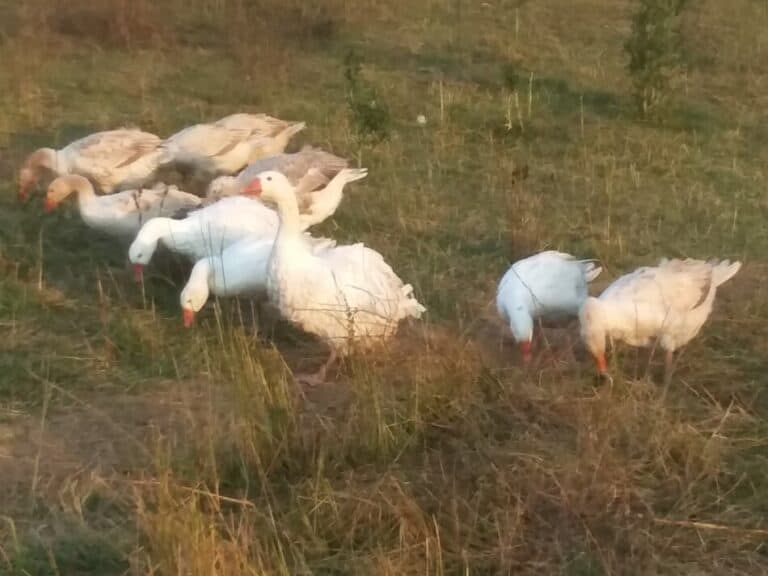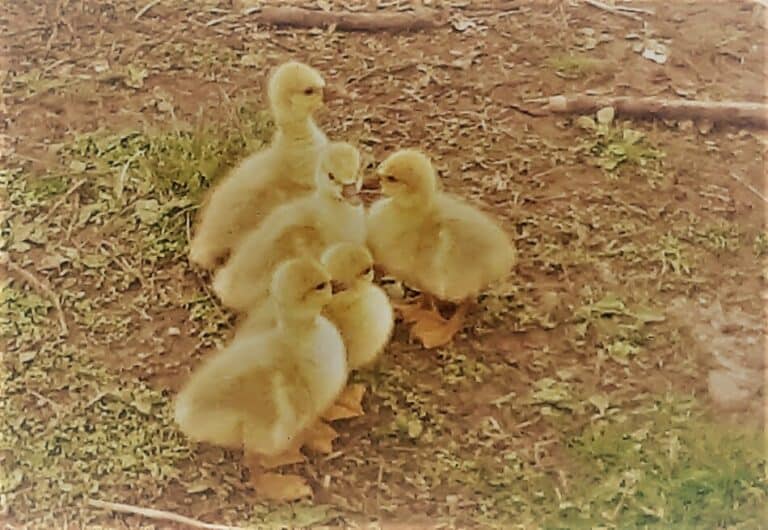What Are The Best Geese For Eating?
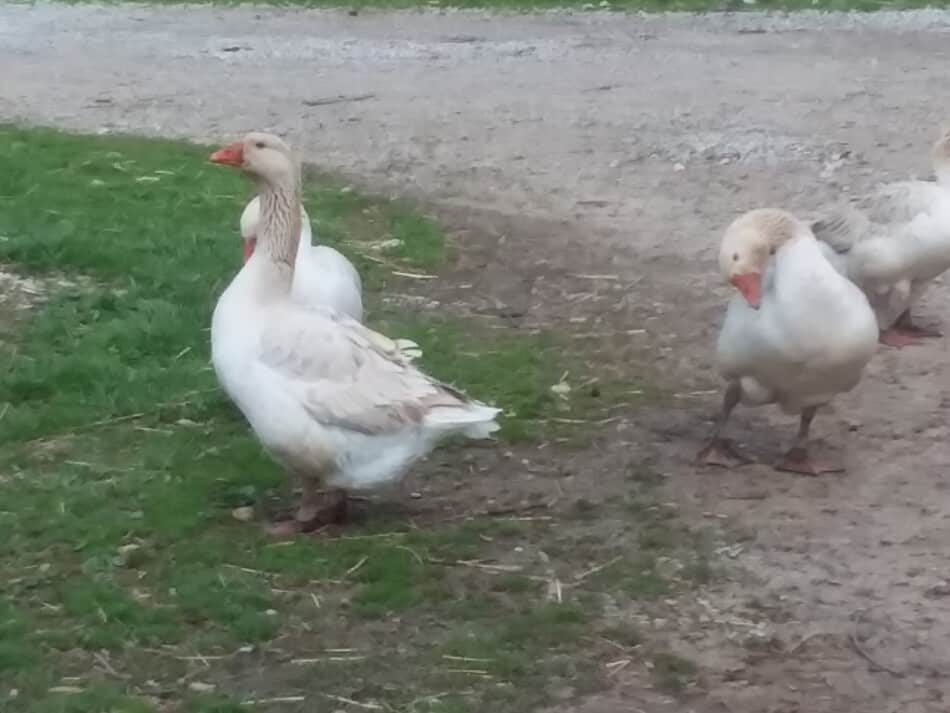
You’ve got a lot of choices when looking for geese to raise for meat. That’s the great news! The not so great news is that you’ll have to pick between them! Which breed of goose will be the best choice as a meat bird?
The best breed of goose to raise for meat is the Embden. Embden geese grow quickly, are commonly available, are meaty and, since they have all white feathers, are easy to pluck.
You can raise and eat any breed of geese that you choose, in the end all geese are meat geese! So the real question ends up being which geese are the ones that will give you the best results for your time and effort.
Is Raising Your Own Geese Worth It? is an article I wrote going over the costs involved in raising your own geese. Check it out if you are looking for the numbers and costs you should be including in your budget.
Choose a fast growing breed of geese
While all geese can end up being used as meat geese, the breeds that make the most sense to use are the ones that give you the fastest growth for your time and feed costs.
You’ll want to choose one of the breeds that have been selected for fast growth, meatiness and fat cover, specifically the Embden.
Why do you want fat cover on your geese? Fat is flavor, birds without fat will not have juicy meat. You’ll still want the fat on the carcass for cooking to keep the meat moist.
Birds without fat, like laying hens, have to be cooked in liquid or they end up stringy. Birds that you plan to roast need to have fat to give you the succulent and tasty resulting roasted goose.
Geese that are slow growers with lower body weights will not have the meatiness or the fat for a great roast goose.
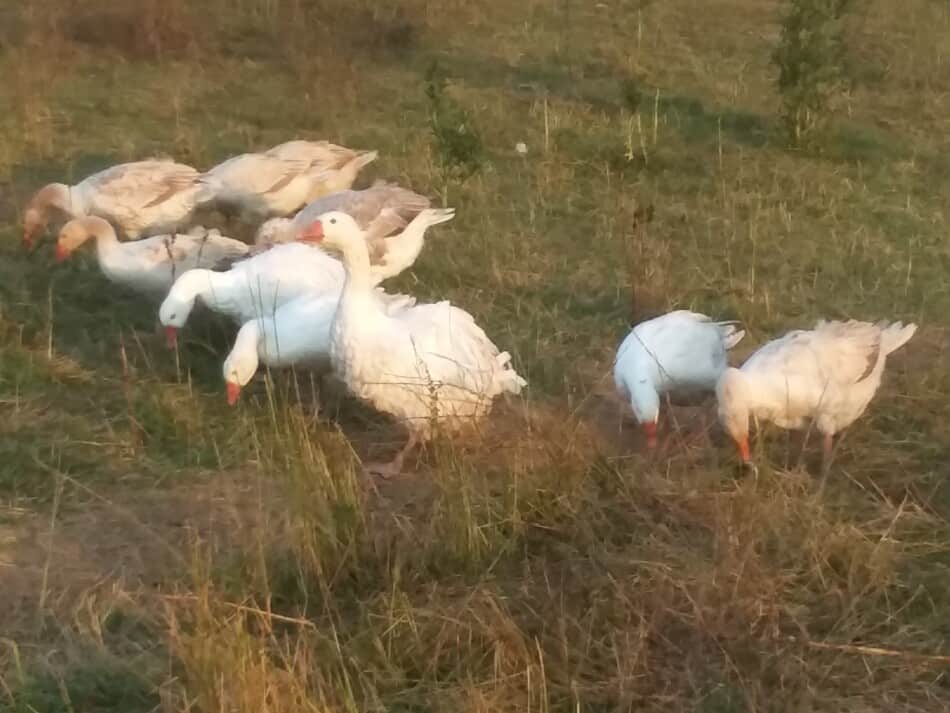
Embden is the most popular meat goose
Embden geese are the most popular meat geese for a reason, they grow quickly and are easy to find. Embden geese will grow well and reach marketable (butchering) weight sooner than other breeds of geese.
If you have the opportunity to by them, Embden cross geese would work well as a meat goose, too.
Depending upon the specific cross they are likely to be a bit slower growing than purebred Embden and not be quite as meaty, but still worth raising.
Toulouse is the most popular traditional meat goose breed
If you are looking for a more traditional type goose to raise for meat, consider the Toulouse. Toulouse geese are a traditional breed of geese raised for meat in France.
These geese will not grow as well as the Embden but are still popular for meat.
I have to admit, I like the looks of a non white bird, to me the more colorful geese are just more interesting and pleasing to the eye.
The trade off here is a bit slower growth and colored pin feathers, but if you want traditional geese, Toulouse are the breed for you!
Large Dewlap Toulouse are not an economical meat goose
There also is a Large Dewlap Toulouse that you may see in the hatchery catalog. These are magnificent birds, to be sure, but not the meat type of Toulouse.
Since this strain of Toulouse is an exhibition type of goose (they’ve been selected for looks not an economical growth rate), they will not be as good of a choice of meat geese as the regular Toulouse.
From what I have seen, the prices of Large Dewlap Toulouse are high (really high!), so the likelihood of anyone purchasing these gosling to use as a meat bird is low. It could be done, just not very economically!
Goose breeds selected for looks will not be as meaty
As mentioned above, any breed of geese can and surely is used for meat.
The difference is what are you getting for your time and money when you decide to buy a more unusual breed of goose for meat?
If I had to guess, you are getting cool looks, but lower finishing weights, less meatiness and slower growth rates compared to the Embden that has been selected for generations to perform as a meat goose.
Anytime we have butchered a goose that was not an Embden, they are always smaller and more thinly built, especially across the breast. The best goose for your time and money is Embden, none of the other breeds can compete.
This is an interesting article on Selecting Geese, from the UK. While there are not a ton of specifics, as far as across breed growth comparison data, it will give you a good place to start.
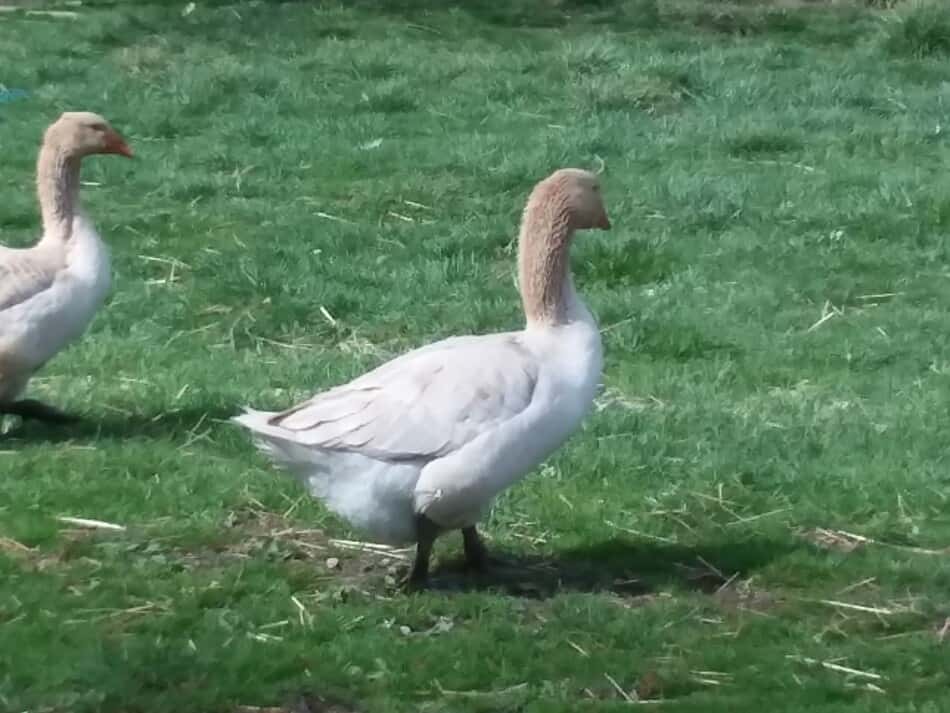
We mainly have American Buff geese in our flock, they sell well as pairs at the local alternative animal and bird sales and are pretty.
I also have a pair of Sebastopols that I’m trying out. They have an interesting look, but not sure how well they perform yet.
We also had an Embden, he was a great looking guy, but we butchered him since he is the one producing the crossbred geese you see in the picture with the Sebastopols above.
The Sebastopol pair is penned separately after Christmas, to keep the breeds separate for breeding season in the spring, so cross breeding is not an issue with them.
If we were keeping a goose breed for meat, it would be the Embden or Toulouse. We’d have to see which would do the best for us on our farm and with our management, then transition the flock to the best breed for us.
If I had to pick one to start with it would be the Embden, you just can’t overlook their results!
Young geese will have a milder flavor
As with most any other meat animal, younger birds have a milder flavor. Most people raising geese for meat would be thinking of processing the geese at 20-24 weeks of age.
As soon as you feel the geese are big enough, they can be eaten. You are raising them to suit yourself, so you are the one who gets to decide how big you want your meat geese.
Obviously, the more they grow, the more meat you get for your efforts. I like to butcher one bird and get more meat, rather than butcher smaller birds and get less meat per bird.
For us, waiting until the geese have more size to them makes sense.
| Live Weight of Meat Goose (pounds) | Dressed Weight of Meat Goose (pounds) | % Carcass Yield |
| 20 | 16 | 80% |
| 18 | 14-14.5 | 78-81% |
| 10 | 7 | 70% |
| 8 | 5.5 | 69% |
Using the table above, you can see that letting your meat geese get bigger will give you more meat from the carcass as compared to butchering them when they are younger.
If you do the math, a 20 pound goose gives you a 16 pound roasting bird, but an 8 pound goose give you a 5.5 pound roasting bird. This means that the bigger goose gives you almost three times as much meat!
Even though the percent yield is only 11% different, the results are much more noticeable as far as meat on your table. This is why we raise the geese to the higher weights.
I know it takes longer to raise a larger goose and they will, of course, eat more. But in return we get a much larger carcass and significantly more meat!
Geese of any age can be eaten, adults will be stronger flavored
We know quite a few people who love to eat geese, they grew up eating goose, and they love the flavor of the adult geese. These folks are what I call traditional eaters, meaning they grew up in a household that cooked real food.
If you weren’t raised a traditional eater, start with the younger geese as meat birds and see how you like the flavor. If you would prefer a stronger taste, just keep your birds around longer before you process them.
Geese can be butchered from 9-24 weeks of age
Younger geese, geese less than 6 months old, are the more popular size and age of meat geese and are what most people raising and eating geese would be planning on.
Some folks like to eat “broiler” geese, these are geese that are 9 weeks old, very close in age to broiler chickens, however, this is less common than waiting until the geese are larger, more like 24 weeks old to butcher them.
Schedule goose processing dates for easiest plucking times
What you really need to watch out for when processing waterfowl is pin feathers!
This is the reason why people who raise geese (and ducks) only butcher at certain ages, it’s not because of the meat, it’s the processing step of removing all of those feathers.
If you are not aware of it, pin feathers come in at certain times and will make plucking that bird much more difficult. Schedule your goose processing around these times.
You want to process your geese at 9, 15 or 20 weeks to minimize pin feathers and make plucking easier. Check out this article at Metzer Farms to learn more.
If you mess up your processing date, you’ll get a goose that is hard to pluck, really hard to pluck. There will be tons of small new feathers coming out of the skin, these can be a nightmare to pluck. I’m not even sure that wax will do it!
I’ve seen a video that showed goose processing at home and the geese looked fuzzy when the plucking was done, yikes! These folks picked a bad week to process their geese, at least in regards to the pin feathers!
To avoid the disappointment, know your dates and process your geese when the pin feathers are the least likely.
Have your processing arrangements made before ordering geese
As I’m sure you have heard, processing dates are becoming more and more scarce, especially for the more unusual meat birds (meaning not meat chickens) like geese.
Call ahead and make your processing arrangements before you order the geese! Yes, before you order. Processors will not be able to fit in your geese when they are already running at maximum capacity.
I have run across multiple processing places that have reduced to meat chickens only or meat chickens only during the busy season, since they are so busy and are best set up to do chickens, not waterfowl.
You can butcher your meat geese at home
You can butcher your geese at home, it’s really not that hard. All you need is time, a knife and some hot water in a tub that the whole goose carcass will fit into.
Any good video on butchering chickens at home will show you all of the steps that you need. If you can find an at home duck butchering video, that will be even better.
You’ll just need different killing cones, if you are using them (we don’t) and more time in the scald. The basics are the same no matter the bird.
Make sure the video is giving you the specifics, like estimated times and how you can tell when the bird is ready for the next step.
Processing Waterfowl, a Metzer Farm article, will give you some recommendations for processing your geese.
The only thing we do differently is we do not add detergent to the water. We used to but have found that it did not make a difference as long as you are swishing the bird around to get all of the feathers wet down to the skin.
We butcher geese at home. We have a plucker, but don’t get it out and hook everything up unless we are doing a big batch of birds. For just one or two birds, hand plucking is fine.
You need to concentrate on the scald, that’s the key to a good plucking experience. Sadly, the scald done wrong is also the key to a poor and very frustrating plucking experience!
Read my article How To Pluck A Chicken Without A Plucker. I know this is on chickens, but check it out anyway, all of the steps are the same.
It will take you a bit longer than the times stated, but plucking a goose by hand is completely doable. We do it all of the time.

